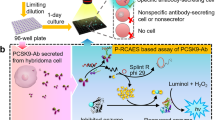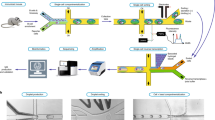Abstract
Here we report a new method for isolating antigen-specific antibody-secreting cells (ASCs) using a microwell array chip, which offers a rapid, efficient and high-throughput (up to 234,000 individual cells) system for the detection and retrieval of cells that secrete antibodies of interest on a single-cell basis. We arrayed a large population of lymphoid cells containing ASCs from human peripheral blood on microwell array chips and detected spots with secreted antibodies. This protocol can be completed in less than 7 h, including 3 h of cell culture. The method presented here not only has high sensitivity and specificity comparable with enzyme-linked immunospot (ELISPOT) but it also overcomes the limitations of ELISPOT in recovering ASCs that can be used to produce antigen-specific human monoclonal antibodies. This method can also be used to detect cells secreting molecules other than antibodies, such as cytokines, and it provides a tool for cell analysis and clinical diagnosis.
This is a preview of subscription content, access via your institution
Access options
Subscribe to this journal
Receive 12 print issues and online access
$259.00 per year
only $21.58 per issue
Buy this article
- Purchase on Springer Link
- Instant access to full article PDF
Prices may be subject to local taxes which are calculated during checkout



Similar content being viewed by others
References
Tokimitsu, Y. et al. Single lymphocyte analysis with a microwell array chip. Cytometry A 71, 1003–1010 (2007).
Tajiri, K. et al. Cell-microarray analysis of antigen-specific B-cells: single cell analysis of antigen receptor expression and specificity. Cytometry A 71, 961–967 (2007).
Ozawa, T. et al. MAC-CCD system: a novel lymphocyte microwell-array chip system equipped with CCD scanner to generate human monoclonal antibodies against influenza virus. Lab. Chip 9, 158–163 (2009).
Kinoshita, K. et al. Identification of antigen-specific B cells by concurrent monitoring of intracellular Ca2+ mobilization and antigen binding with microwell array chip system equipped with a CCD imager. Cytometry A 75, 682–687 (2009).
Yamamura, S. et al. Single-cell microarray for analyzing cellular response. Anal. Chem. 77, 8050–8056 (2005).
Jin, A. et al. A rapid and efficient single-cell manipulation method for screening antigen-specific antibody-secreting cells from human peripheral blood. Nat. Med. 15, 1088–1092 (2009).
Meierhoff, G., Ott, P.A., Lehmann, P.V. & Schloot, N.C. Cytokine detection by ELISPOT: relevance for immunological studies in type 1 diabetes. Diabetes Metab. Res. Rev. 18, 367–380 (2002).
Helms, T. et al. Direct visualization of cytokine-producing recall antigen-specific CD4 memory T cells in healthy individuals and HIV patients. J. Immunol. 164, 3723–3732 (2000).
Czerkinsky, C.C., Nilsson, L.A., Nygren, H., Ouchterlony, O. & Tarkowski, A. A solid-phase enzyme-linked immunospot (ELISPOT) assay for enumeration of specific antibody-secreting cells. J. Immunol. Methods 65, 109–121 (1983).
Czerkinsky, C. et al. Reverse ELISPOT assay for clonal analysis of cytokine production. I. Enumeration of gamma-interferon-secreting cells. J. Immunol. Methods 110, 29–36 (1988).
Wrammert, J. et al. Rapid cloning of high-affinity human monoclonal antibodies against influenza virus. Nature 453, 667–671 (2008).
Love, J.C., Ronan, J.L., Grotenbreg, G.M., van der Veen, A.G. & Ploegh, H.L. A microengraving method for rapid selection of single cells producing antigen-specific antibodies. Nat. Biotechnol. 24, 703–707 (2006).
Matsumoto, S.E. et al. In vitro immunization can elicit the expansion of diverse repertoire of B cells from peripheral blood mononuclear cells. Cytotechnology 52, 227–233 (2006).
Jin, L., McLean, P.A., Neel, B.G. & Wortis, H.H. Sialic acid binding domains of CD22 are required for negative regulation of B cell receptor signaling. J. Exp. Med. 195, 1199–1205 (2002).
Ozawa, T., Kishi, H. & Muraguchi, A. Amplification and analysis of cDNA generated from a single cell by 5′-RACE: application to isolation of antibody heavy and light chain variable gene sequences from single B cells. Biotechniques 40, 469–470, 472, 474 passim (2006).
Jin, A. et al. Generation of TRAIL-receptor 1-specific human monoclonal Ab by a combination of immunospot array assay on a chip and human Ab-producing mice. Eur. J. Immunol. 40, 3591–3593 (2010).
Acknowledgements
We thank S. Hirota for technical assistance and K. Hata for secretarial work. We are very grateful to M. Isobe and N. Kurosawa for their helpful discussions. This research was supported by grants from the Hokuriku Innovation Cluster for Health Science Project of the Ministry of Education, Culture, Sports, Science and Technology, Japan.
Author information
Authors and Affiliations
Contributions
H.K. conceived of the ISAAC method. H.K. and A.M. supervised the project. A.J. designed and performed experiments. T. Obata developed the chip and A.J. tested it. A.J., T. Ozawa and K.T. tested and showed the utility of the protocol.
Corresponding authors
Ethics declarations
Competing interests
H.K. and A.M. are unsalaried directors of SC World Inc.
Rights and permissions
About this article
Cite this article
Jin, A., Ozawa, T., Tajiri, K. et al. Rapid isolation of antigen-specific antibody-secreting cells using a chip-based immunospot array. Nat Protoc 6, 668–676 (2011). https://doi.org/10.1038/nprot.2011.322
Published:
Issue Date:
DOI: https://doi.org/10.1038/nprot.2011.322
This article is cited by
-
Single-cell deep phenotyping of IgG-secreting cells for high-resolution immune monitoring
Nature Biotechnology (2017)
-
Sensing cell-secreted molecules
Bioanalytical Reviews (2012)
-
Target-selective joint polymerase chain reaction: A robust and rapid method for high-throughput production of recombinant monoclonal antibodies from single cells
BMC Biotechnology (2011)
Comments
By submitting a comment you agree to abide by our Terms and Community Guidelines. If you find something abusive or that does not comply with our terms or guidelines please flag it as inappropriate.



